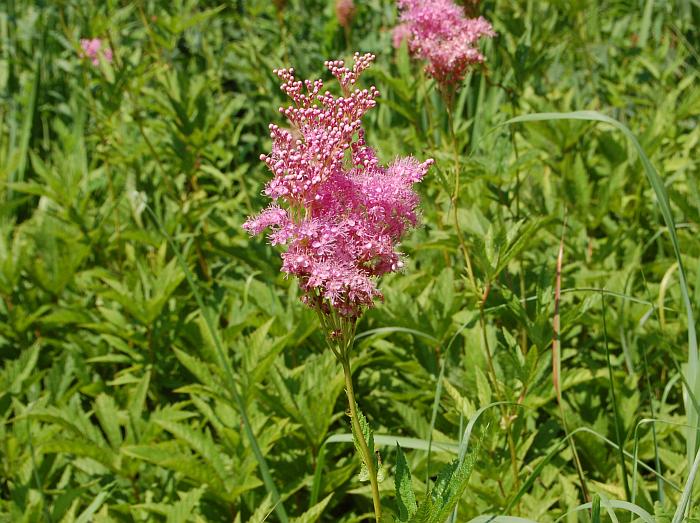Filipendula rubra (Hill) B.L. Rob.
Queen Of The Prairie

Native
CC = 10
CW = -5
MOC = 6
SRank = S2
© SRTurner
Filipendula rubra (Hill) B.L. Rob.Queen Of The Prairie | |
 |
Native CC = 10 CW = -5 MOC = 6 SRank = S2 |
© SRTurner |
|
Family - Rosaceae Habit - Rhizomatous perennial forb. Stem - Ascending to erect, to 2.5 m glabrous, hollow, finely ridged.
Leaves - Basal and alternate, petiolate, stipulate. Stipules large, herbaceous, the rounded to cordate bases clasping the stem, those of the basal leaves fused to the petioles. Leaf blades 8-50 cm long, broadly obovate in outline, once pinnately compound (the uppermost leaves sometimes merely palmately lobed) with small leaflets at the base and irregularly interspersed among the larger ones, the margins sharply toothed and shallowly pinnately lobed, the upper surface glabrous, the undersurface finely hairy, mostly along the veins, the primary lateral leaflets mostly 2-10, 2-15 cm long, mostly ovate-circular and deeply palmately 3-7-lobed, the terminal leaflets larger than the lateral ones, nearly circular to broadly fan-shaped or kidney-shaped, palmately 5-9-lobed.
Inflorescences - Dense terminal panicles of numerous flowers, lacking bracts.
Flowers - Perigynous, the hypanthium shallowly cup-shaped, glabrous, somewhat fleshy. Sepals 5, 1.0-1.6 mm long, reflexed, oblong a with rounded tip, glabrous, white- to pink-tinged and usually noticeably veiny, persistent at fruiting. Petals 5, 2-4 mm long, obovate, pink. Stamens 15 to numerous, the anthers pink. Pistils 5-15 in a single whorl. Ovary superior, glabrous, with 1 locule, with 2 ovules. Style 1 per pistil, curved, persistent at fruiting, the stigma capitate.
Fruits - Achenes appearing similar to follicles, ascending, 5-8 mm long, linear to narrowly oblong, straight or somewhat curved, often tapered to a short stalk at maturity, glabrous. Flowering - June - August. Habitat - Fens. Origin - Native to the U.S. Lookalikes - None. Other info. - This striking and beautiful species has been collected from only 6 counties in Missouri. It is considered imperiled in the state, with a conservation ranking of S2. Its range includes the upper Midwest and Northeast, as well as parts of Canada, but it is uncommon virtually everywhere it occurs. It is easily recognized when in flower by the unique appearance of the inflorescences. Photographs taken at Shaw Nature Reserve, Franklin County, MO, 6-23-2006, 6-11-2007, 6-10-2012, and 6-13-2019 (SRTurner). |